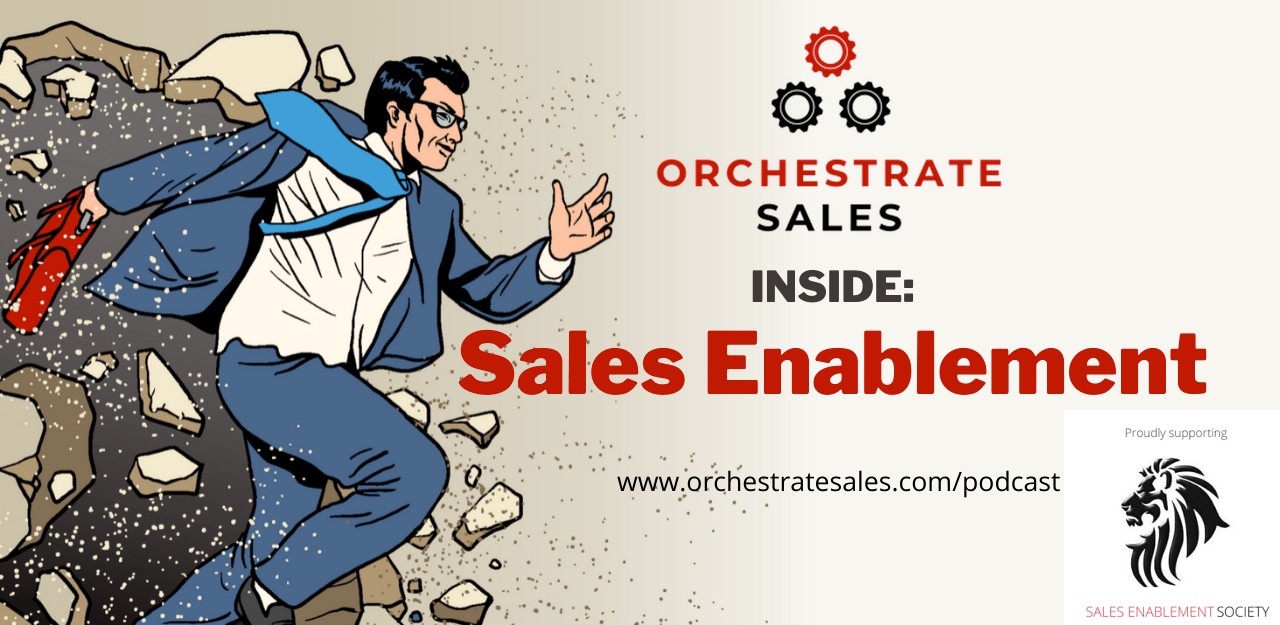Ep10 Accelerate the Sales Process & The NYPD
Welcome to the Inside Sales Enablement Podcast, Episode 10
Are you:
- overloaded by your inbox?
- concerned with the myriad of things being asked of the salesforce?
- Worried you might be contributing to the chaos?
How would you like to move from being highly reactive to how you are enabling revenue growth, to being more proactive?
In this episode, Brian Lambert & Scott Santucci discuss practical applications of using five (5) sales objectives to help diagnose root cause problems and then prescribe more integrated programs that move the needle.
Highlights in this podcast
1) How do you apply the 80/20 rule to sales enablement?
2) What are the five (5) universal sales objectives (and how are they NOT a sales methodology)
3) How companies who follow this disciplined approach have win rates as high as 70%
4) Understand then for yourself first, and then figure out how to socialize them internally
5) Good conversations about strategies on socializing the ideas inside your company.
Join us at https://www.OrchestrateSales.com/podcast/ to collaborate with peers, join Insider Nation, participate in the conversation and be part of the continued elevation of the profession.
EPISODE TRANSCRIPT:
Nick Merinkers 00:02
Welcome to the inside sales enablement podcast. Where has the profession been? Where is it now? And where is it heading? What does it mean to you, your company, other functions? The market? Find out here. Join the founding father of the sales enablement profession Scott Santucci and trailblazer Brian Lambert as they take you behind the scenes of the birth of an industry, the inside sales enablement podcast starts now.
Scott Santucci 00:33
Hi, I'm Scott Santucci.
Brian Lambert 00:35
And I'm Brian Lambert and we are the sales enablement insiders. Our podcast is dedicated to asking the big questions that you should be asking if you want to be successful in sales enablement. You know, Scott, we're surrounded by lots of information. There's a lot of ideas on what we can be doing on a daily basis. And quite frankly, there are a lot of choices that we can be making in sales enablement to be successful. One of the things that I wanted to do on this podcast is this idea of focusing on what matters. And when it comes to what matters. It's often the little things that can get us the most traction. Scott, can you frame that out for us?
Scott Santucci 01:16
Sure, Brian, Malcolm Gladwell published a book, and I think it was 1999 or 2000, called the tipping point. And in that book, he talks about a lot of stories about how change happens. And one in particular that I think's relevant is one about the New York City Police Department. And specifically, back in the early 80s, New York City, believe it or not had a lot of crime. And the crime was out of control. There was a whole bunch of strategies to do that. But the New York Police Department followed a strategy that seemed pretty strange. And the idea was any little thing. Stop it. So, for example, and they saw somebody drunk on the street, they didn't give them a warning. They put them up and they detained them when any graffiti went up on the on the subways, they cleaned it off immediately. And just by doing these very little things, guess what happened? crime in New York City declined 60 some odd percent. And that's a dramatic change. And that strategy became adopted throughout the country as we saw a massive decrease in crime across the United States.
Brian Lambert 02:28
As usual, Scott, that's a great story. But what does that have to do with sales enablement? Obviously, we're not going to be arresting people. What are you talking about?
Scott Santucci 02:37
Well, I like these framing, framing conversations to help us think a little bit differently, but really what it matters, and what we're talking about here is how little things make a big difference. And that where many of us are as sales enablement professionals, is the inbox seems like it's killing us. We're overloaded by all these different activities. And is it really moving the needle? And how do we actually start figuring out where to focus on the small and a few?
Brian Lambert 03:11
Yeah, that's a great point. There's so much stuff, right. So not only the inbox, but meetings. I don't know about some of our listeners, but it feels like I'm strapped to my chair all day long every single day. And the idea of any whitespace or the you know, working through anything, is just tough because I'm always responding or fighting a fire or handling some sort of issue or, you know, if you have a staff, you've got people write vacations, somebody else sick, somebody got hurt, etc. So, you know, there's so many things that we can be doing the question that you're posing, which I love is, you know, what should we be doing? You know, Yeah, great question. And
Scott Santucci 03:51
if you don't know me, I'm a big fan of using math. I'm very mathematical and the way I think, and this is really what we're leveraging here is the 8020 role. And you know, since this is inside sales enablement, the 8020 rule is a is a principle developed by an Italian mathematician, really observing that 20% of the choices lead to 80% of the outcomes. And this phenomenon has come up over and over and over again. So, it's studying that mathematical principle or the statistical principle. And while we're at Forrester, when we had a whole bunch of different data points, one of the things that I did is applied back and I tried to look for look for different patterns, and for simplicity, and really what we ended up coming up with or reduced down sales, no matter what kind of sales that you're doing, whether you're inside sales, whether you're strategic account sales, whether you're a geographic salesperson, a vertical salesperson, no matter what no matter what it is that you're selling. There are only five universal objectives objectives, you must meet only five
Brian Lambert 05:01
Yeah, that's great. So, I'm sure we're gonna go through these five. But let's, let's, let's pause before we do it. What's the difference between objectives as you're defining here? And the concept of activities or actions or quote unquote, priorities?
Scott Santucci 05:17
That's a great question. For me, it's pretty simple. I can accomplish a task or a goal by doing a million things, or one thing. So, what happens is that in a lot of cases, we over prescribed sellers, a whole bunch of things to do. And then they feel obligated to do all those things when they can get creative and just accomplish that objective one way or another. What mat- you know what matters is, if you if we were to use a different analogy here, before we get into the details about sales, it matters that you score the touchdown. Doesn't really matter how you score the touchdown. It matters that you get the first down it doesn't really matter how you get the first down. Now, obviously in those sports, you have to do plays and make sure your blocking assignments are achieved, etc. But at the end of the day, you hit the first down, you make the first down, you keep the drive alive, you score the touchdown, you score points, end of story, black and zero, are black and white one and zero, it's binary. And that's really the the idea here is what are the five binary things that are ones or zeros that we can know we either did or we didn't do so that we can communicate to everybody else that sales is actually an awesome game. There's no such thing as an expected value or a weighted a weighted goal or a distributed outcome or any of the other math that that we tend to be applying to this, this pipeline game. It comes down to ones and zeros. So, what are the ones and zeros that we need to we need to check off in engineering or manufacturing sales pipeline?
Brian Lambert 07:02
Yeah, I love it. And I've certainly used at 20. I've used these five objectives. And they do they do netted out and I love, and this is important, I think for the listeners, as it was for me this binary nature ones and zeros and what pops into my head? Scott, I know we've talked a lot about this movie but it's Moneyball, right? So, you know, we can we have batting averages, we've got, you know, all you look at all of the score sheets on a player, you've got all this all these numbers, and Billy Beane and Moneyball said, you know what our job is to get on base and getting on base and getting a base hit as binary, you either do or you don't. And you built the whole team around that. That's the same thing here is the binary nature of these five objectives. You either help sellers do it, or you don't. So that's awesome. Let's, let's hear what they are. Why don't you walk us through those?
Scott Santucci 07:53
Sure. Before I walk you through those. What I'm going to do is, Brian, you're throwing me for a curveball. You didn't bring up money. balling our prep call, but I'm going to roll with it. So, what I'm going to do is I'm going to try to toggle back and forth between Moneyball and and these five sales objectives. So, I'm going to go through the five sales objectives really, really quick first, and then we'll talk about each one, there are only five things, five things, that's it five things that any salesperson needs to do. The first one is know who your target audience is. The second one is to be able to have at get access to that particular person. The third thing is to have a successful meeting with that person. The fourth one is to create a shared vision or a buying vision or whatever you want to call it a shared vision of success with the client. And the last one is to present to them a business case that they accept and frame this out the target and at the end of the first one, knowing your target is your on deck, you're getting ready for hitting the gaining access is getting on first base, having a successful meaning is getting on second base, create a shared vision is third base and creating a business cases home, you've scored a run.
Brian Lambert 09:15
Yeah, that makes sense. And, you know, obviously, if you don't do them in that order, you know, it's not gonna work. And also, you either did it or you didn't. That's binary, like we talked about. And another thing that this does, Scott, you know, in my role I deal a lot with, for example, l&d professionals or trainers. And I'm thinking that this helps with is, you know, not dealing with the outliers. So, we've talked at 20 these are the 20 that we want to focus on this is the these are the principles or the objectives that cut through a lot of the noise. But if we're if we're losing sight of that, or perhaps, you know, not as disciplined as we as we need to be on the on the base, running and getting on base, and then the first second third You know, and then home. And we focus on other things like the weather conditions or, you know, whether the suns in our eyes or what we're eating for lunch. Just kidding. You know, but but there's a lot of distractions through the inbox, etc, right, so you can lose sight of the game and the objectives and in the l&d space, I've spent a lot of time, you know, saying, okay, those are things that we could be doing we Yes, we could spend time on making sure that the elearning is better, or Yes, we could be spending a lot more time on the assessments or whatever. There's a lot of things we could be doing, but what should we be doing to help sellers, in this case, get on first base, and does that really matter? And I think that's a critical piece of this whole concept.
Scott Santucci 10:47
And let's let me go through let's go through each of them with a little bit of color. So as basic and as simple as that sounds, and this is one of the phenomenon that I've encountered. When you bring something Simple to people they rejected. But what they want is something simple. It's this whole, what simple is a very paradoxical conversation. But let's talk with just target audience. Who are you selling to? Who do you want to sell to? In most cases, I get an answer like, well, we want to sell it a large enterprise companies or to the mid market. And when I asked more specifically, like, who is the wallet owner, that you're targeting? Who is your primary stakeholder? Very few companies can actually answer that question. And so right from the get-go, we're not really focused on people. We're focused on sort of generalities.
Brian Lambert 11:49
Yeah, and then also because, you know, this is our on-deck piece, right. So, you know, I oftentimes get well, you know, at first, we try to go to this All, but then we need to over you know, be in a different role and they start talking about, you know, a bunch of people instead of the specific entry point into the account or the specific wallet owner, that should maybe talk to you first.
Scott Santucci 12:13
Right and, and it's, the entry point would be the gaining access point, right. And the goal here is really to say, who is our ideal stakeholder that we want to be communicating to, it's unlikely that every seller all the time is going to get access to that person. But the reason going through this exercise is so important. If we just apply a little simple math here, a CIO, if that's who we're trying to target, their budget and access to funding might be 100 x more than an individual user. So, the reason that this is very important, is because we want to make sure that the efforts that we're doing is targeting individual people who have buying authority. And that buying authority tends to be higher level people. Obviously, we don't want to try to think everything that we need to do, we need to call them a CEO. That's ridiculous. But that's why I've actually really spending the time to figure out who your target is, is incredibly important. In most cases, companies that I've worked with very large, well known smart individuals don't have that information, or they don't have that agreement on who they're who they're targeting. So that creates a lot of problems for Problem number two, which is okay, now that we're at bat, we want to get access to somebody. So, in the game, getting access to that somebody let's think about the workflow of a regular salesperson. They have a whole key of different leads that they're that they're given. In many cases, we've always heard that salespeople don't fall but leads I myself when I was a salesperson, chose to not follow up on the leads. I was given for marketing, because the level that they were at were so far low level a I'd be restricted to people who maybe had a $20,000 budget and I was trying to sell with people with lots you know, with with adult money, or, or b it was gonna make me start a campaign way low and then the work that I'd have to do to navigate all the different stakeholders up to the person who can make a decision was making the job of me selling much more difficult. So, the goal of the of the gain access is how do we actually gain access? And then if you can imagine all of this stuff, do we have the right call scripts for doing that? as a salesperson, I'd love to roleplay out with other sellers like techniques done on press day for it. How do we do that if we're not clear on who it is that we're targeting, in terms of the demand generation or the handoffs or the content or the collateral or all of the different activities, by the way, it's exploding now with email and social media and outreach or Reference programs, all of the different things just to get a meeting is great, but I need to get a meeting with somebody. So that's, that. That's all of the activities. And to your point about being distracted, there's a lot of distractions just getting on first base.
Brian Lambert 15:15
Yeah. And also, in today's world, you know, there's, there's so many there are so many platforms, but there are also a lot of, you know, point solutions. So, you know, what's your thoughts, Scott, on what we're selling, you know, the solutions that we're selling, or the product that we're selling as it relates to getting access, right? Because, depending on where and who the specific who the sellers are going after, you know, for example, CIOs may not care to engage in a conversation about something that's super tactical. So, you know, they're gonna ignore you
Scott Santucci 15:50
The way that I think about this simply 8020 rule, so this will happen at you know, a percent of time. Of course, somebody listening here is going to be able to find an exception but Let's concentrate on the rule not not the not the outlier. If you think about it this way, if you're prospecting, you should probably never talk about your products. If you have inbound stuff going on and they they're bringing up products, well, then it's okay to talk about products. It's kind of that easy.
Brian Lambert 16:19
Yeah. Makes sense. So, when it becomes what, you know, that challenge that the that you're talking to up to that person about needs to be about the challenges that they're having, not necessarily your products. That's right. How does that help get a successful meeting?
Scott Santucci 16:34
Well, we have to have access first, so that they will agree to meet with us. Now, obviously, on a phone call, if you get them at the right time, you might be able to move into that first meeting. But realistically, you're probably going to want to set that up and schedule it out. So, in the first in the first access, you framed out a particular issue. Now we're having our first meeting. And I don't know about you, I remember myself as the seller, I don't know if anybody else is listening to this is carrying a bag or have heard this from any anybody who's is carried a bag. You go into a meeting and you walk out, and you think, dang it, I wish I would have just brought up x y&z and that goes into the preparation. So really the goal of base to get back to your Moneyball analogy, Brian, in a successful meeting, it's, let's pre let's already have an idea of the common business objectives that they've got, and map different ways that we can initiate or help them explore it. That's very knowable, especially if we already know who the stakeholder is. We shouldn't put all that burden on our reps. And we sure as heck shouldn't try to do that all in a pitch deck. Because a pitch deck is the biggest red flag to an a to adult money wallet owner, they say I'm not gonna spend time with this particular individual Because they are not going to be able to help me solve my problem, they're just going to be able to regurgitate some really slick, slick materials.
Brian Lambert 18:09
Right. And and in the idea of a successful meeting, sellers today can probably make the assumption that there are more people involved than, than this one buyer that there's there's probably a network of folks. So, you know, if you're if you're in a PowerPoint mode, you won't be able to tailor because when you walk into the meeting, you actually may have multiple, as a seller, you may have multiple people in there, or you need to have a sequence of meetings to string it all...




